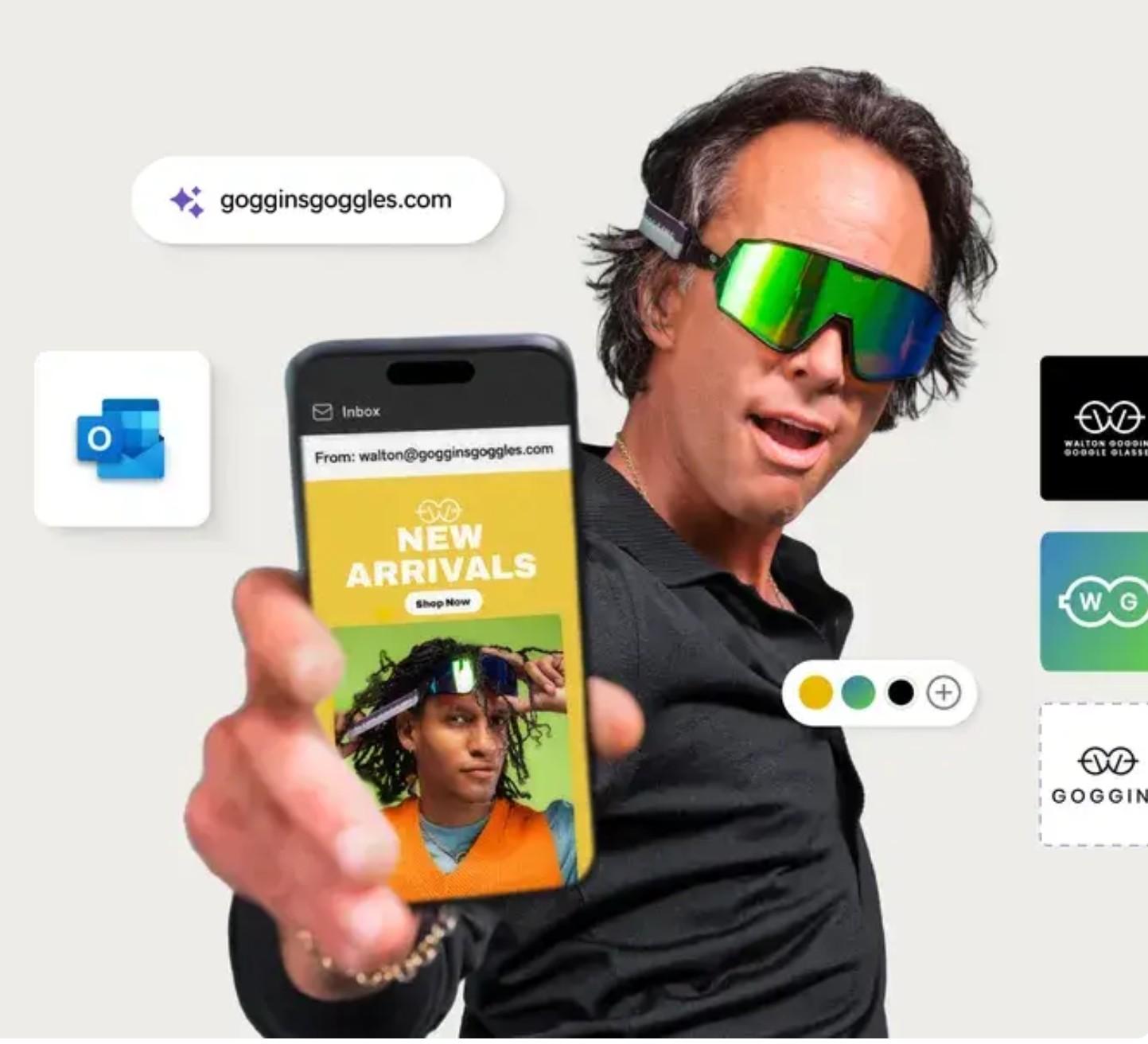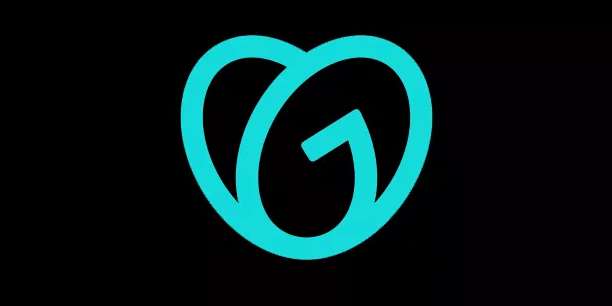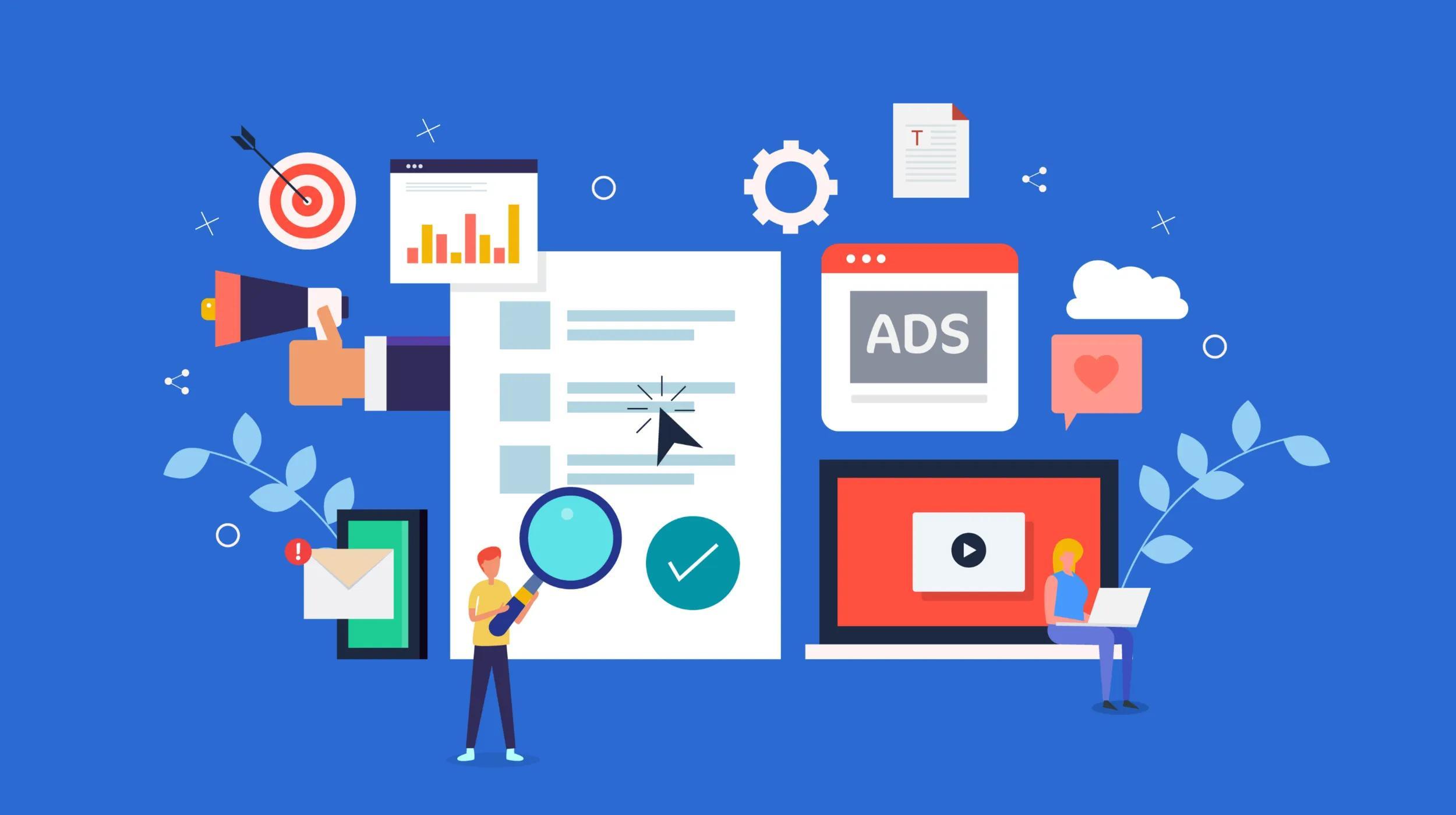There’s no question social media can grow your business, but not every brand does it well.
Some post inconsistently or try to be everywhere at once. Others burn the budget on ads that never convert. And then there are those that build real communities, turn followers into customers, and use data to sharpen every move they make.
This guide is here to help you be in that last group.
Whether you’re just getting started or refining a mature strategy, we’ll walk through how to set up the right channels, what works best on each platform, proven marketing strategies, and examples of businesses that got it right.
If you're ready to turn likes into leads, read on!
How to set up your social media channels
Before you can build an audience or run campaigns, you need a solid foundation. That means setting up your social media channels correctly so your brand looks professional and trustworthy and is fully searchable from day one.
Here’s how to do it:
1. Choose the right platforms
Not every platform is right for every business. To land on the right ones for your company, start by thinking about:
- Where your audience hangs out. Are they professionals (LinkedIn), visual shoppers (Instagram), or video consumers (YouTube, TikTok)?
- What kind of content you’ll share. Can you create short-form videos regularly? Do you have high-quality visuals? Or, are you focused on thought leadership and B2B updates?
- What your goals are. Are you looking to build brand awareness, work on lead generation, offer customer support, or sales? Each platform supports different outcomes.
Most small businesses start with setting up accounts on two to three platforms that best align with their content strengths and audience. Then, if they need to, will expand to other platforms later.
2. Claim your handle everywhere
Even if you don’t plan to post on every platform (and you probably shouldn’t when starting out), secure your brand name across the board. This protects your identity and gives you the option to grow into those spaces later. This applies to new social media platforms, too. When a new platform launches, secure that username ASAP.
You can use tools like BrandSnag to quickly see availability across major platforms.
3. Optimize each profile
Every channel has its own quirks, but these fundamentals apply across the board:
- Profile image: Use a high-resolution logo or brand-consistent headshot.
- Bio or about section: Be clear, concise, and keyword-friendly. State what you do and who you help.
- Link in bio: Use a direct link to your website or a tool like Linktree if you want to feature multiple links.
- Contact info: Add an email, phone, or chat option if the platform supports it.
- Cover or header image: Customize this with seasonal promotions or brand messaging when possible.
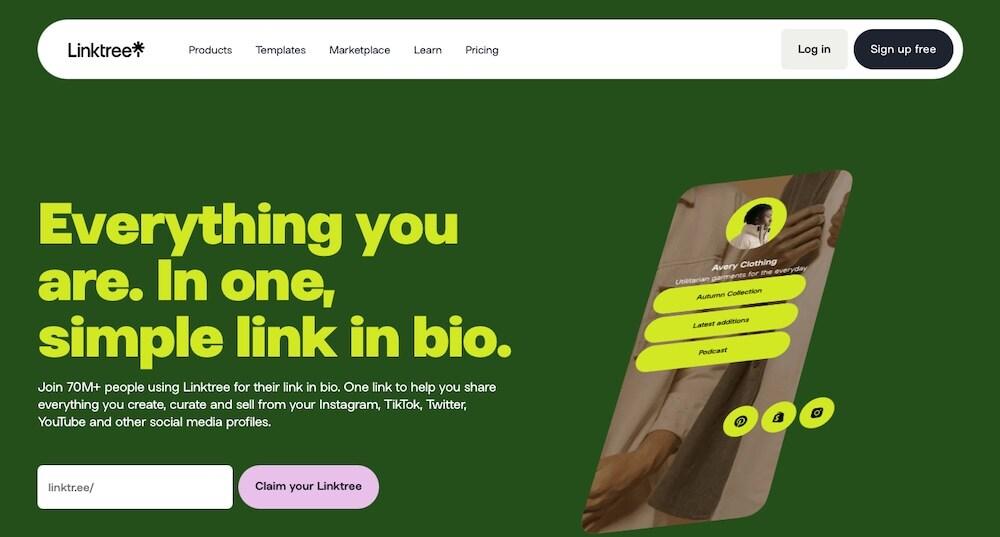
These are just a few key steps for optimizing your brand’s online presence and overall website branding and should be done no matter what platform you use.
4. Align your visuals and tone
Your brand should feel familiar no matter where someone finds you. That means you should use the same logo and colors across all social platforms.
You should also write in a consistent tone of voice. So, if you adopt a friendly tone on TikTok, don’t suddenly switch to something sarcastic on X/Twitter.
Syncing profile descriptions where possible is a good idea, too, but customize each one for the platform’s audience
For instance, your LinkedIn summary may sound more professional than your Instagram bio, but they should both reflect the same brand values.
5. Set up roles and permissions
If you’re working with a team, assign admin roles carefully. Do this before you commit to any sort of posting schedule to cut back on confusion and mistakes.
Most platforms let you:
- Add team members with limited access.
- Use a social media management tool like Hootsuite or Sprout Social to control publishing permissions.
- Keep login credentials secure with a password manager.
6. Integrate with your website and tools
Make sure visitors can easily find your social channels from your website, and vice versa. This is often quite simple. Add icons or links to your social accounts in your site’s header or footer.
You can also embed social feeds directly on your website. It’s popular to do this with Instagram and X feeds.
Another option is to connect tools like GoDaddy Studio to automatically share blog posts across your accounts — including Facebook, Instagram and Google Business.
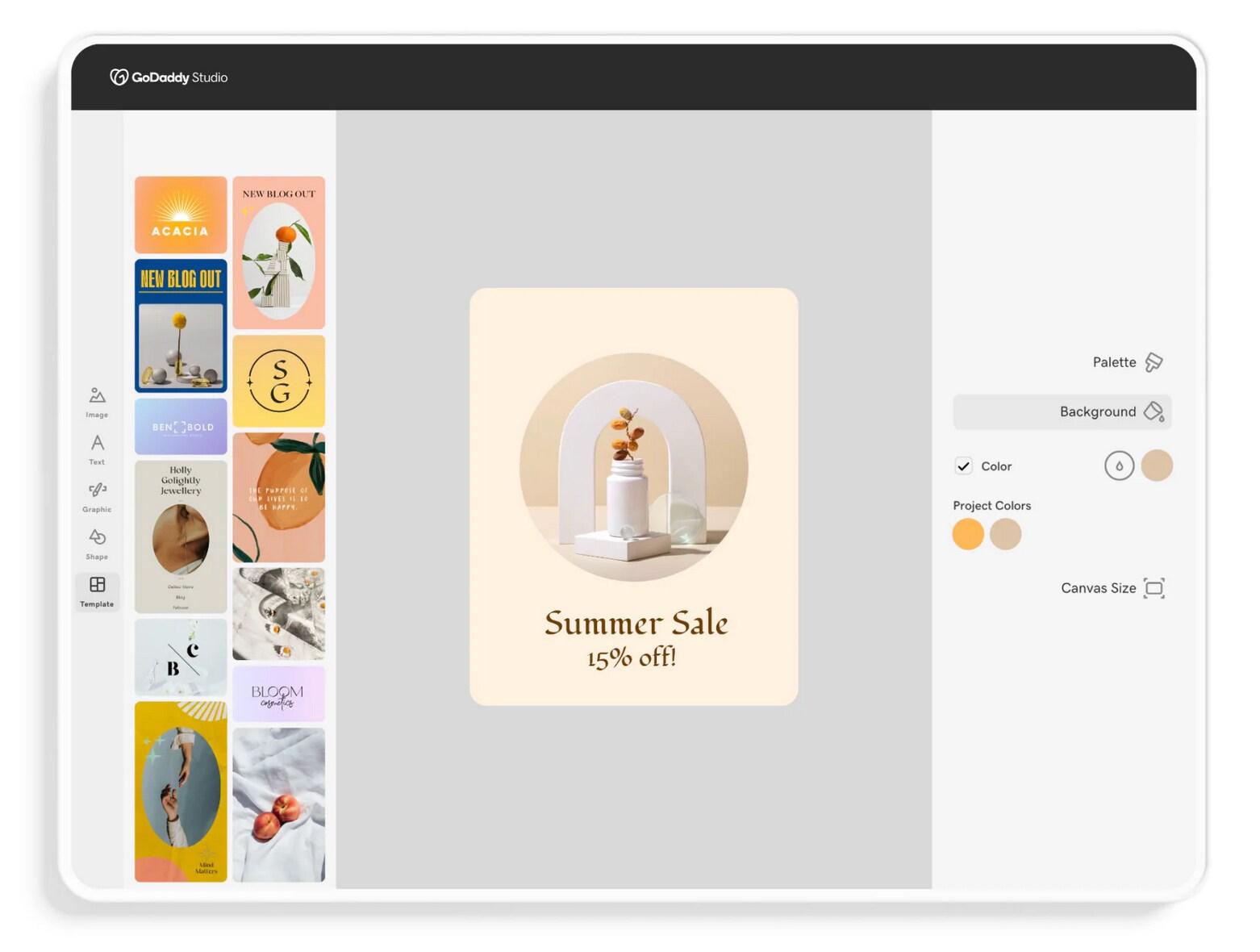
Understanding social media platforms
Not all social media platforms serve the same purpose, so trying to treat them the same is one of the fastest ways to waste your time.
Below, we’ll explore how each of the major platforms works from a business perspective, so you can focus your energy where it will actually have an impact on your company’s visibility.
Facebook for Business
Facebook is still one of the most powerful tools for business, especially if your audience is over 30. With over 3 billion monthly active users, it’s ideal for both organic reach and paid campaigns.
Facebook Groups is where customers can connect, ask questions, and share experiences. It's also a strong channel for distributing content like blog posts, event announcements, or behind-the-scenes updates that keep your audience engaged.
From an advertising perspective, Facebook offers some of the most advanced targeting tools available, allowing you to reach specific demographics based on location, interests, behavior, and more. You can run these campaigns using Facebook Ads Manager and track performance directly within Meta Business Suite, which also helps with post scheduling and insights.
If you’re in ecommerce, Facebook integrates with Meta Shop to let you tag products in posts and enable shoppable experiences. And for customer service, Messenger can be set up to handle everything from live chat to automated responses, which keeps your support fast and always on.
Instagram for Business
Instagram is a visual-first platform, making it an ideal space for brand-building, storytelling, and showcasing products in action. With a core audience aged 16 to 34, it’s especially effective for businesses targeting younger, mobile-savvy consumers who gravitate toward polished imagery and short-form video content.
Brands often use Instagram to highlight lifestyle photos and curated product shots, while Reels offer a major opportunity for reach and engagement thanks to the platform’s emphasis on video.
Influencer collaborations and user-generated content also thrive here, helping businesses build trust and community through authentic storytelling. Features like Stories and link stickers make it easy to drive traffic directly to your website, product pages, or lead forms.
For ecommerce businesses, Instagram Shopping allows you to tag products in your posts and create a smooth buying experience without ever leaving the app.
Tools like Creator Studio help with content scheduling and performance tracking, while “link in bio” services like Linktree give you a simple way to guide people to multiple destinations from a single profile link.
Twitter/X for Business
Despite its change in name, X, the platform still plays a meaningful role for real-time updates, thought leadership, and B2B engagement, particularly in industries like tech, news, and politics.
Businesses often use X to share blog posts, product announcements, and timely insights, while also participating in trending conversations or live event hashtags to increase visibility.
For many brands, X is also a fast and informal customer service channel. Quick replies to questions or complaints can improve customer satisfaction and build trust.
Additionally, many founders and team leads use the platform to cultivate a personal voice, sharing behind-the-scenes thoughts or commenting on industry developments to establish credibility.
To manage activity more efficiently, tools like X Pro (formerly TweetDeck) allow for multi-account control, while platforms like RiteTag support hashtag research and content planning. If you’re working with a team or planning in advance, Buffer and Hootsuite can help with scheduling and performance tracking.
That said, X has seen significant shifts in user behavior and reach in recent years. It’s a smart platform to use if your target audience is already active there, but not necessarily one to prioritize if you're starting from scratch.
LinkedIn for Business
LinkedIn is the go-to platform for B2B marketing, talent recruitment, and building thought leadership. With its professional tone and business-focused user base, it’s particularly effective for brands targeting decision-makers, industry professionals, and corporate buyers.
Unlike faster-paced platforms like Instagram or TikTok, LinkedIn tends to reward high-quality, long-form content, especially when it’s insightful and backed by data or experience.
Many businesses use LinkedIn to publish leadership insights, industry analysis, or case studies that position their team as experts. It’s also a powerful networking tool, helping you connect directly with peers, clients, or potential hires.
To maximize your presence, explore tools like LinkedIn Ads for lead generation or content promotion, and use LinkedIn Analytics to monitor engagement and audience growth over time.
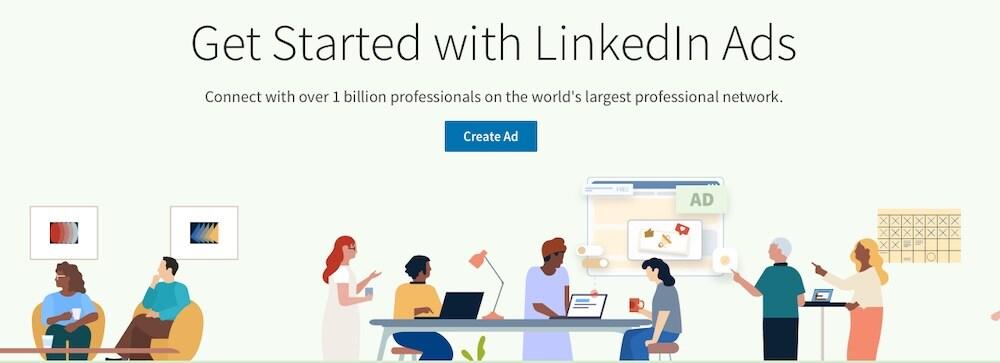
Company Pages also include features like native newsletters, product tabs, and pinned posts, which are great for highlighting your latest insights or initiatives.
YouTube for Business
YouTube is more than just a platform for watching videos. It’s actually the second-largest search engine in the world, making it an incredibly powerful tool for businesses focused on visibility, education, and long-term brand building.
It's especially well-suited for evergreen content like tutorials, product explainers, and deep-dive storytelling that continues to generate views long after it's published.
Businesses commonly use YouTube to create dedicated channels for how-to videos, unboxings, product demos, and customer testimonials, all of which build trust and help potential buyers make informed decisions.
Longer videos tend to perform well here, particularly when optimized for SEO, making YouTube a great place to establish your authority and generate search traffic.
Tools like YouTube Studio allow you to manage everything from editing to publishing and tracking your subscriber count. Adding chapters and timestamps can make your content more accessible and help viewers find the exact sections they need.
And for brands wanting to tap into the short-form video trend, YouTube Shorts offers a vertical-friendly format for quick, engaging clips that boost discoverability.
TikTok for Business
TikTok has become a serious growth engine for consumer brands, creators, coaches, and service-based businesses. Its algorithm prioritizes discoverability, giving brands a chance to reach large audiences organically, especially when they embrace short-form storytelling and engaging visuals.
Popular content formats include product showcases, quick tips and tutorials, behind-the-scenes glimpses, and participating in viral challenges or trends.
The platform is especially effective for connecting with Gen Z and millennial audiences. 77% of Gen-Z who answered a survey indicated they use TikTok to find products.
And both these generations respond well to authentic, entertaining content that doesn’t feel overly polished.
For brands looking to scale, TikTok for Business offers powerful ad tools and performance tracking.
The Creator Marketplace makes it easy to connect with influencers who already engage your target audience, and CapCut provides a mobile-friendly editing workflow for creating standout videos quickly.
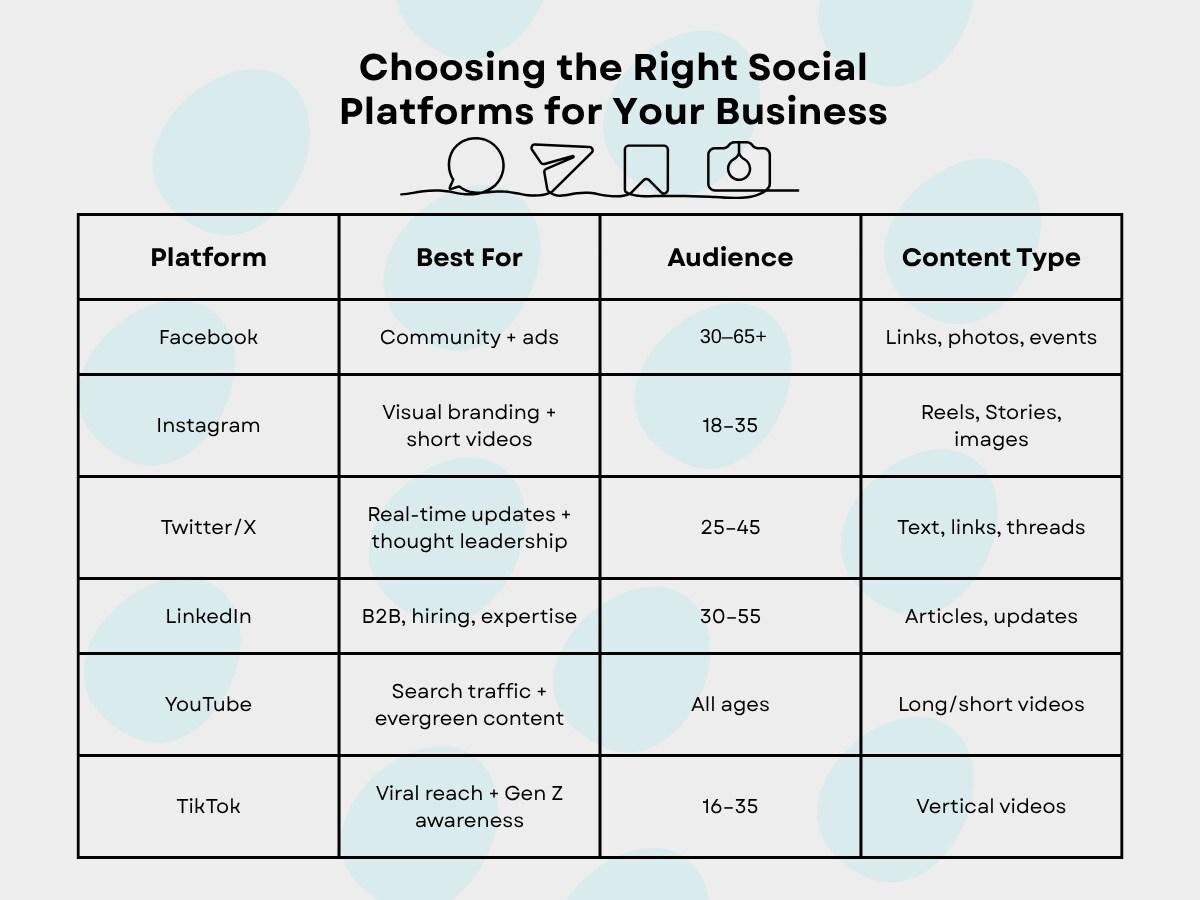
Strategies for social media marketing
Once your accounts are set up and aligned with your brand, it’s time to focus on what you’ll actually do with them.
Successful social media marketing isn’t about being everywhere or posting constantly. It's about delivering the right content, to the right people, at the right time. That takes a mix of planning, creativity, data, and execution.
Here are four essential strategies every business should understand and apply consistently to get the best results out of their time spent on social media.
Content creation and curation
Your content is the bridge between your brand and your audience. It’s how you show your personality and demonstrate your expertise to build real trust over time.
But not everything needs to be 100% original. Sharing the right curated content is just as valuable, especially when you add your unique perspective. Here are a few tips for both approaches:
Tips for content creation
- Use the 80/20 rule: Aim for 80% value-driven content (educational, inspirational, entertaining) and just 20% promotional. Constant selling turns people off.
- Mix content formats: Static images are fine, but video performs better across most platforms. Include carousels, reels, short-form tutorials, customer spotlights, and even memes.
- Repurpose long-form content: Have a blog post that performed well? Turn it into an Instagram Story, a LinkedIn carousel, or a 60-second TikTok summary.
- Tell real stories: Customers don’t just want specs. They want to see how your product or service fits into real life. Share testimonials, behind-the-scenes clips, or “a day in the life” videos from your team.
For instance, if you run a fitness brand, you could post client transformations, a quick nutrition tip reel, and a behind-the-scenes photo from your latest shoot, all in the same week.
Content curation tips
- Share relevant industry news: Add your perspective to trending stories to show you're plugged in.
- Repost user-generated content (UGC): Shout out customers who tag your brand. It builds community and trust.
- Highlight your partners: Show off collaborations, tag vendors, or share how you support other small businesses.
Influencer marketing
Influencer marketing has changed a lot over the past few years. Micro-influencers (typically under 100K followers) often have more engaged audiences and feel more relatable to everyday users.
You don’t need a huge budget to get started, just a clear sense of who you’re targeting and why. Here are a few tips for getting started:
- Start small: Look for creators in your niche with loyal followers. Think: a local food blogger, a niche YouTube reviewer, or a TikTok skincare fan.
- Focus on alignment: Don’t just chase numbers. Look at engagement rates and the tone of their content. Do they speak your audience’s language?
- Be clear about deliverables: Spell out expectations, like how many posts, what platforms, key messages, and how to disclose sponsorship.
- Use affiliate links or discount codes: This helps you directly track ROI and incentivizes the influencer to promote authentically.
Paid advertisements
Organic reach is getting harder to maintain, especially on platforms like Facebook and Instagram. That’s why paid social media has become such an essential component to building a social presence.
Paid ads help you reach new audiences quickly, retarget website visitors, and promote time-sensitive offers. The key is to start small and build on what works.
Common ad types include:
- Boosted posts: Simple way to increase the reach of your best-performing content.
- Lead generation ads: Collect emails or signups directly within Facebook or LinkedIn.
- Carousel ads: Great for showcasing multiple products, features, or testimonials.
- Video ads: Highly engaging on TikTok, YouTube, and Instagram Reels.
When running paid campaigns, be sure to start small. You don’t need a huge ad budget to test what works. Even $5/day can help you learn.
Then, you’ll want to test variations of your ads. Use A/B testing to compare copy, headlines, and visuals. To further segment your offers, use custom audiences and retarget site visitors or social engagers with personalized messages.
Finally, be sure to measure everything but focus on what matters most. Don’t get caught up in likes. Instead, track and evaluate clicks, cost-per-action, and conversions.
If you're using GoDaddy for your website and marketing, you can connect your social media and ad campaigns directly through GoDaddy's Digital Marketing Suite to simplify setup and reporting.
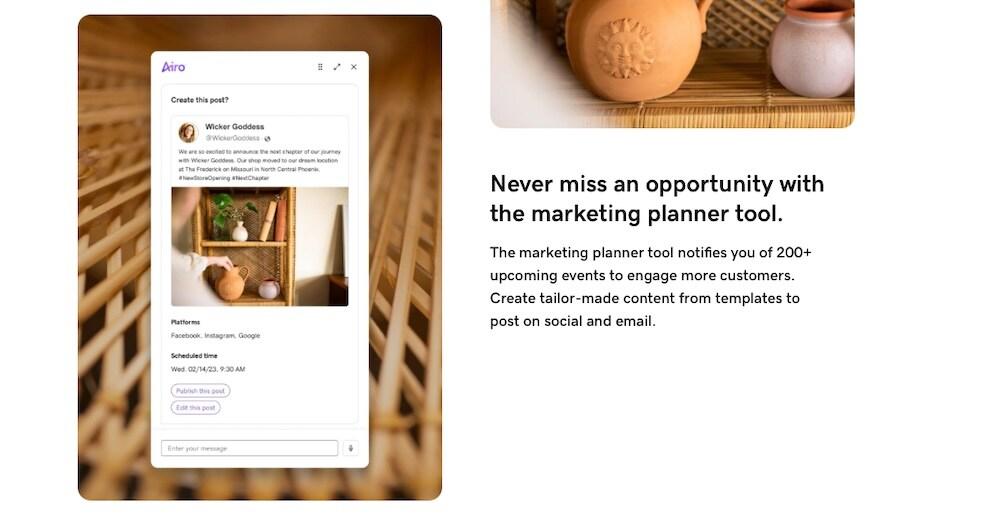
Social media analytics
If you’re not tracking performance, you’re just guessing. Social media analytics show you what’s working and what to stop wasting time on.
Even the best-performing posts won’t mean much if you don’t understand why they performed.
A few key metrics to track, no matter which social media sites you’re using include:
- Engagement rate: Shows how your audience interacts with your content (likes, comments, shares).
- Reach and impressions: Measure brand visibility. How many people are seeing your posts?
- Click-through rate (CTR): Are people clicking your links, watching full videos, or visiting your site?
- Conversion rate: Tracks how many users take a defined action like signing up or buying something.
Be sure to add UTM parameters to every link you post so you can track exactly which platforms, campaigns, or posts are driving traffic in your analytics dashboard.
Case studies: Successful social media campaigns
Let’s take a look at how some of the most successful brands turned smart social media strategies into real business results. This way, you can see what’s possible when creativity meets execution.
1. McDonald’s: Grimace Shake TikTok Trend (June 2023)
The purple Grimace Shake took over TikTok back in 2023, where users dramatized its messiness (and alleged sinisterness) and created a playful viral trend. McDonald’s then jumped in with amusing responses on X.
Impact:
- Boosted shake sales
- Spiked engagement thanks to the brand’s clever replies.
Takeaway: Even unplanned viral moments can be wins if you engage quickly and playfully.
2. e.l.f. Beauty: TikTok led to community growth (2023)
e.l.f. built its TikTok presence through hashtag challenges and UGC, allowing fans to shape the brand’s story in 2023.
Impact:
- Massive reach with zero celebrity spend.
- Positive sentiment from authenticity and community energy.
Takeaway: User-generated content can generate a ton of brand awareness without a big influencer budget.
3. Nike: No Pride, No Sport campaign (2023)
This multi-platform campaign that included Instagram, TikTok, and YouTube put the spotlight on LGBTQ+ athletes sharing their stories.

Impact:
- Emotional resonance and engagement.
- Aligned brand values with social identity.
Takeaway: Values-based storytelling builds deeper emotional connections.
4. Duolingo: “Duo’s Death” campaign (Feb 2025)
Duolingo dominated with playful, platform-savvy content, generating over 3 billion impressions back in 2023 then again in early 2025 with a cheeky “Duo’s Death” viral moment where the company staged the owl mascot’s demise by means of a wayward Cybertruck.
Impact:
- Year-over-year impressions were up 170% in 2023.
- 2025 stunt generated 1.7 billion impressions.
- Consistent buzz via humor and memorable visuals.
Takeaway: A strong, consistent personality makes a mascot or brand instantly recognizable.
5. Dunkin’: Halloween Spider Donut campaign (Oct 2024)
Dunkin’ snuck a spider-themed donut into its lineup, promoting it with coyly provocative posts on Instagram via a takeover by a character named Spidey D.

Impact:
- One of the brand’s most successful social efforts.
- Direct sales lift tied to the campaign.
Takeaway: The right mix of humor, teasing, and seasonal relevance can make limited-time items work really well on social media.
6. Coca‑Cola: Global “Share a Coke” revival campaign (April 2025)
Coca-Cola relaunched its iconic personalized bottles globally, pairing it with QR codes and a mobile hub for customers to create digital memes and videos with their names.
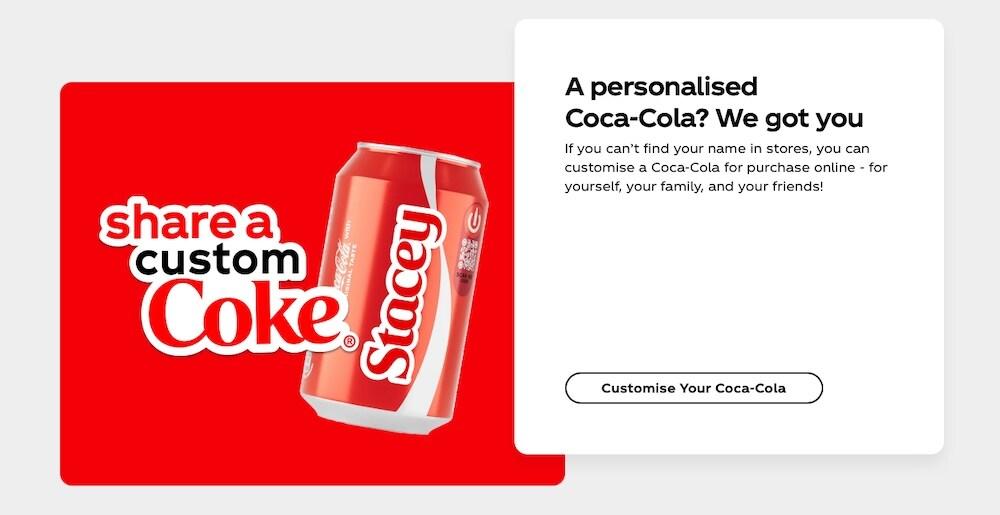
Impact:
- Multi-country campaign spanning over 120 nations.
- Blended physical and digital sharing to resonate with Gen Z.
Takeaway: Nostalgia coupled with personalization in a digital-first twist can powerfully reengage younger audiences.
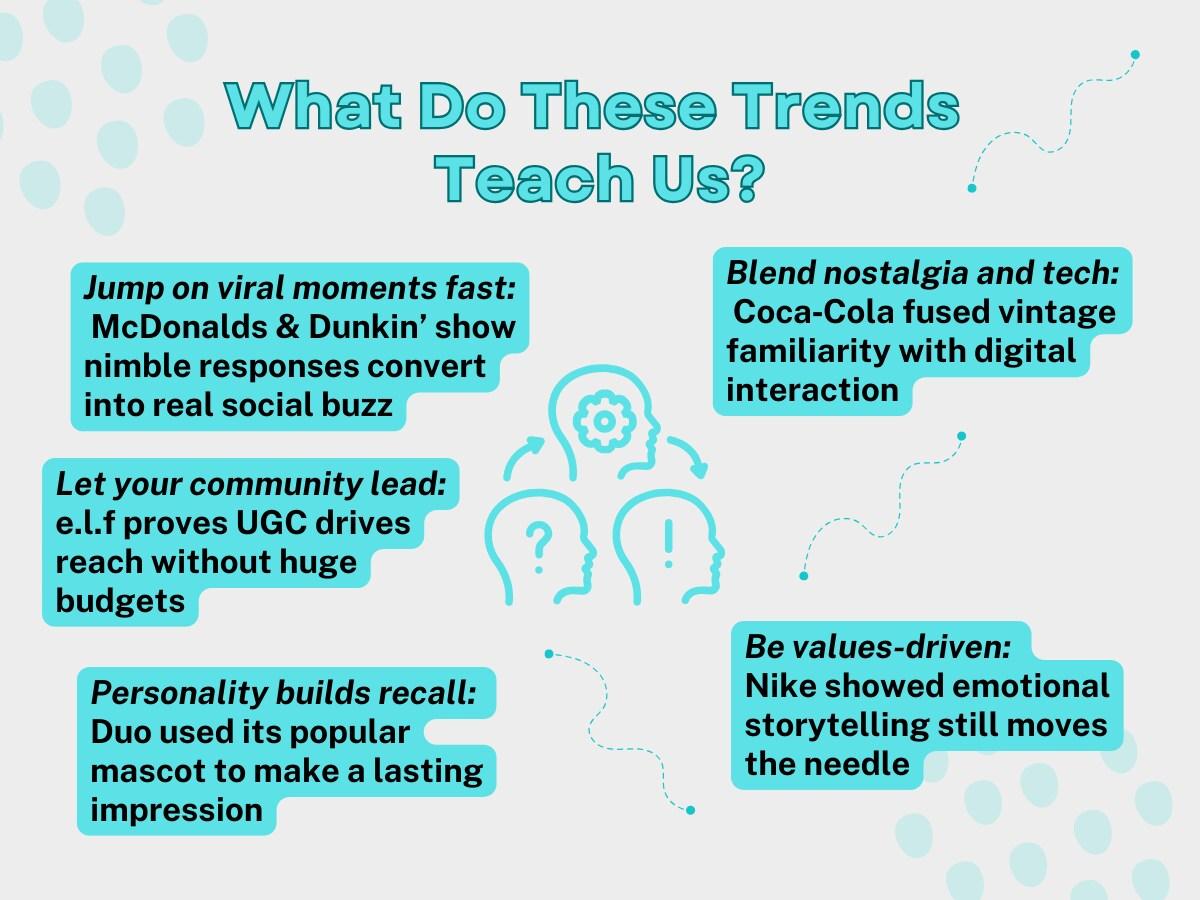
Implementing your social media strategy
Social media success doesn’t come from doing everything. Rather, it comes from doing the right things consistently.
Start by choosing the platforms that make sense for your business and setting up your profiles to reflect your brand.
From there, focus on creating content that’s actually useful or entertaining, not just promotional. Mix in paid ads, collaborate with creators when it fits, and keep a close eye on your analytics to guide what happens next.
The most successful brands — whether it’s Nike, Duolingo, or your favorite local shop — win on social media by being authentic, responsive, and intentional.
And the truth is, you don’t need a huge team or a massive budget to start seeing real results. You just need a strategy, a few tools, and the discipline to keep showing up.
Disclaimer: All known trademarks contained herein are the property of their respective owners and their inclusion does not represent any affiliation, endorsement, or sponsorship.

